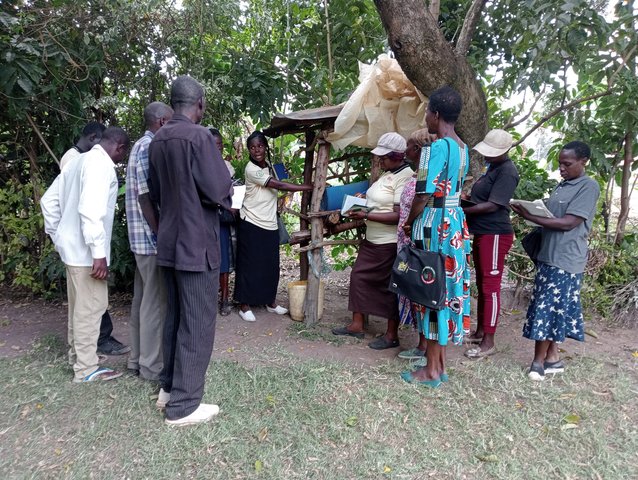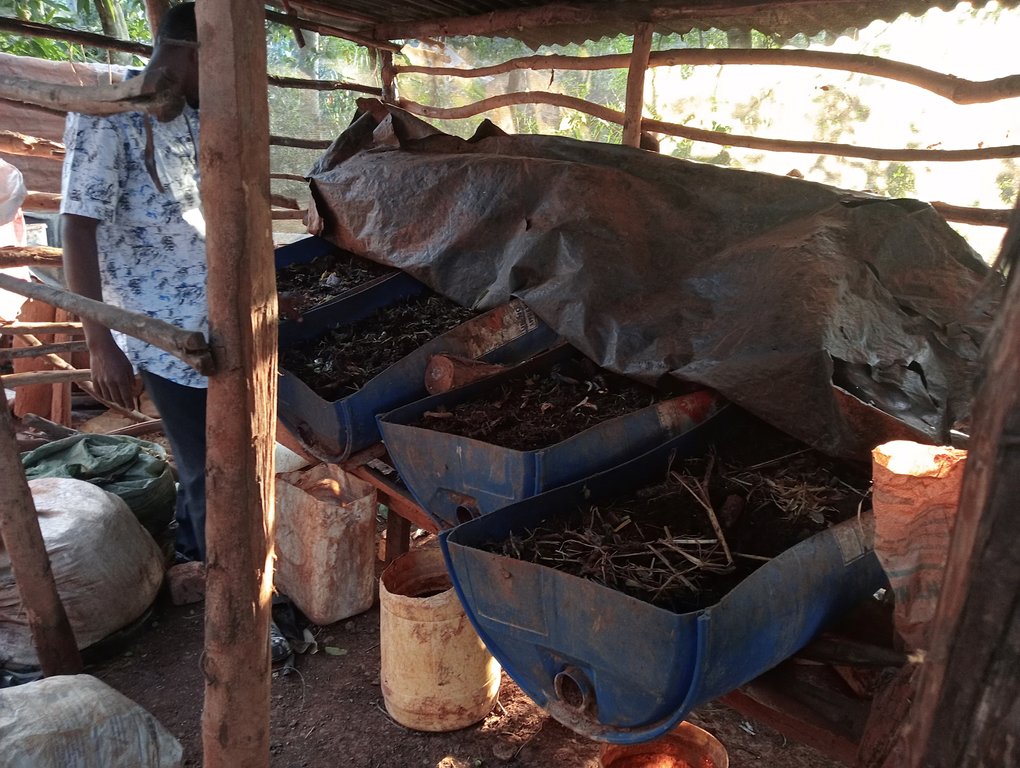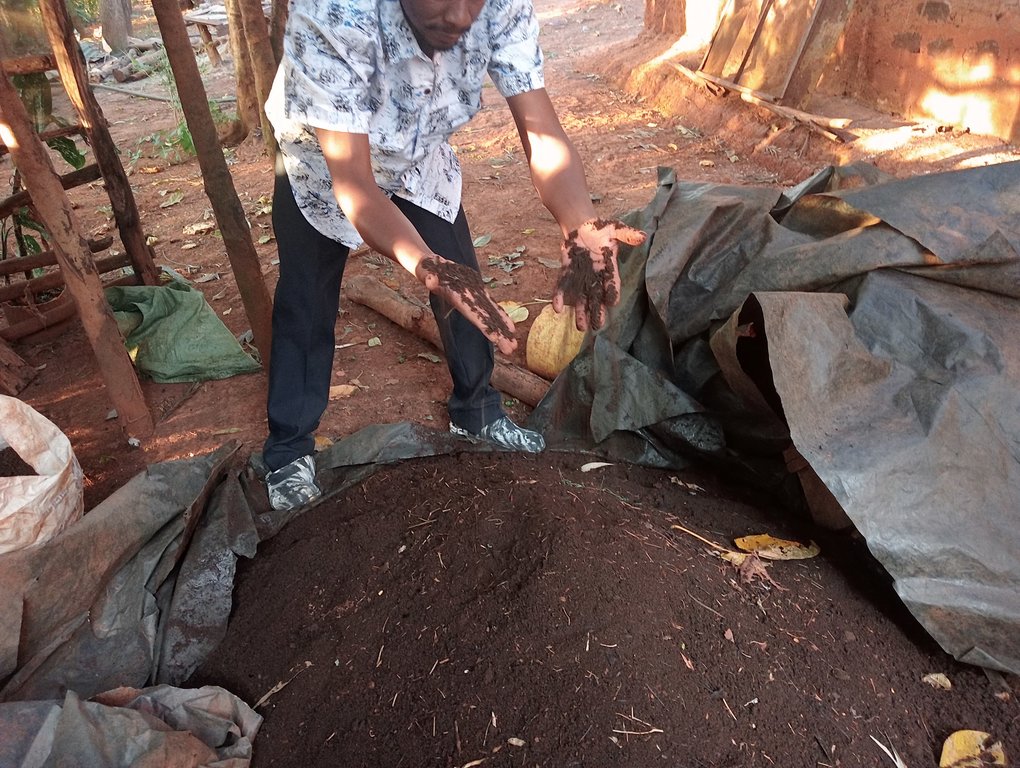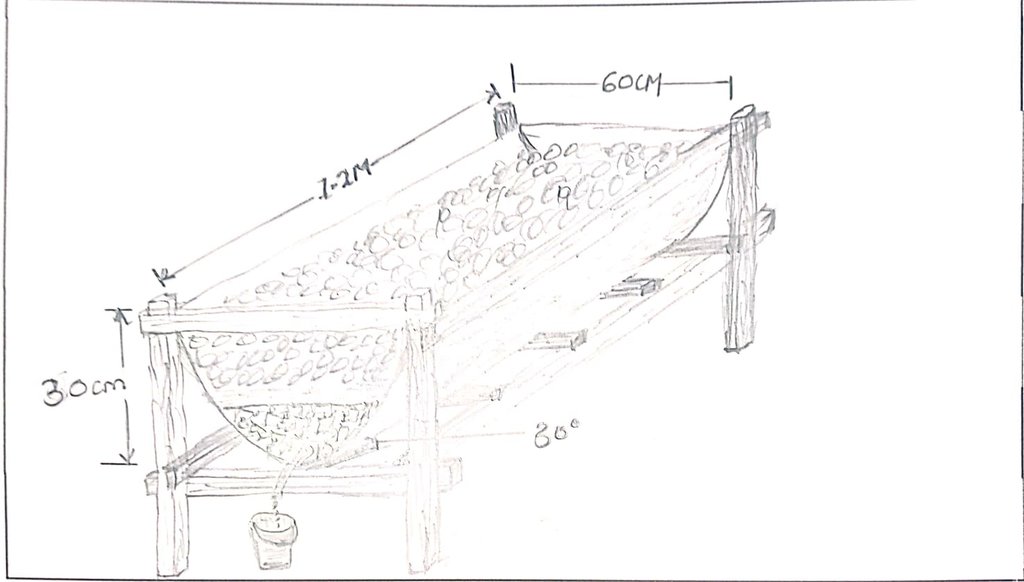Vermicomposting: an effective liquid fertilizer and biopesticide [ប្រទេសកេនយ៉ា]
- ការបង្កើត៖
- បច្ចុប្បន្នភាព
- អ្នកចងក្រង៖ William Akwanyi
- អ្នកកែសម្រួល៖ George Onyango, Innocent Faith, Noel Templer, Tabitha Nekesa, Ahmadou Gaye, Siagbé Golli
- អ្នកត្រួតពិនិត្យច្រើនទៀត៖ William Critchley, Rima Mekdaschi Studer, Sally Bunning
technologies_6685 - ប្រទេសកេនយ៉ា
ពិនិត្យមើលគ្រប់ផ្នែក
ពង្រីកមើលទាំងអស់ បង្រួមទាំងអស់1. ព័ត៌មានទូទៅ
1.2 ព័ត៌មានលម្អិតពីបុគ្គលសំខាន់ៗ និងស្ថាប័នដែលចូលរួមក្នុងការវាយតម្លៃ និងចងក្រងឯកសារនៃបច្ចេកទេស
បុគ្គលសំខាន់ម្នាក់ (ច្រើននាក់)
អ្នកប្រើប្រាស់ដី:
Mururi Wamunga Job
Welthungerhilfe farmer
ប្រទេសកេនយ៉ា
អ្នកជំនាញឯកទេស SLM:
អ្នកជំនាញឯកទេស SLM:
ឈ្មោះគម្រោងដែលបានចងក្រងឯកសារ/ វាយតម្លៃលើបច្ចេកទេស (បើទាក់ទង)
Soil protection and rehabilitation for food security (ProSo(i)l)ឈ្មោះអង្គភាពមួយ (ច្រើន) ដែលបានចងក្រងឯកសារ/ វាយតម្លៃបច្ចេកទេស (បើទាក់ទង)
Deutsche Gesellschaft für Internationale Zusammenarbeit (GIZ)ឈ្មោះអង្គភាពមួយ (ច្រើន) ដែលបានចងក្រងឯកសារ/ វាយតម្លៃបច្ចេកទេស (បើទាក់ទង)
Alliance Bioversity and International Center for Tropical Agriculture (Alliance Bioversity-CIAT) - ប្រទេសកេនយ៉ា1.3 លក្ខខណ្ឌទាក់ទងទៅនឹងការប្រើប្រាស់ទិន្នន័យដែលបានចងក្រងតាមរយៈ វ៉ូខេត
អ្នកចងក្រង និង(បុគ្គលសំខាន់ៗ)យល់ព្រមទទួលយកនូវលក្ខខណ្ឌនានាទាក់ទងទៅនឹងការប្រើប្រាស់ទិន្នន័យដែលបានចងក្រងតាមរយៈវ៉ូខេត:
បាទ/ចា៎
1.4 សេចក្តីប្រកាសស្តីពីចីរភាពនៃការពណ៌នាពីបច្ចេកទេស
តើបច្ចេកទេសដែលបានពណ៌នានេះមានបញ្ហាដែលផ្តោតលើការធ្លាក់ចុះគុណភាពដី, បើដូច្នេះវាមិនអាចត្រូវបានប្រកាសថាជាបច្ចេកទេសនៃការគ្រប់គ្រងប្រកបដោយចីរភាពទេ?
ទេ
មតិយោបល់:
Farmers who have used vermicompost and vermijuice have recorded good harvests and there are no adverse impacts on their farms.
1.5 ការយោងទៅលើកម្រងបញ្ជីសំណួរ (មួយ ឬច្រើន) នៃវិធីសាស្ត្រផ្សព្វផ្សាយ SLM (ដែលបានចងក្រងដោយទស្សនៈពិភពលោកស្តីពីវិធីសាស្ត្រ និងបច្ចេកទេសងអភិរក្ស WOCAT)

Community Resource Persons (CRP) in agricultural extension [ប្រទេសកេនយ៉ា]
Community Resource Persons (CRP) form a farmer-to-farmer learning approach that bridges the gap in agricultural extension, increases farmers' access to agricultural information (SLM knowledge), and increases the adoption of SLM practices.
- អ្នកចងក្រង៖ William Akwanyi
2. ការពណ៌នាពីបច្ចេកទេស SLM
2.1 ការពណ៌នាដោយសង្ខេបពីបច្ចេកទេស
និយមន័យបច្ចេកទេស:
Vermicomposting is an on-farm waste management strategy where worms are used for biodecomposition of wastes to produce a natural liquid fertilizer and pesticide.
2.2 ការពណ៌នាលម្អិតពីបច្ចេកទេស
ការពណ៌នា:
Vermitechnology is biodecomposition of wastes using worms such as red wigglers. It includes vermicomposting (production of compost) and vermiculture (production of worms to ensure sustainability of the enterprise).
A vermicomposting structure is installed under shade and covered with a black polythene sheet to protect worms from the heat of the sun, and to prevent volatilization of nitrogen. The structure itself can be made by cutting a 60 cm radius and 120 cm height drum into two halves lengthwise. The half to be used must be thoroughly cleaned of oil or chemical residue. A hole is drilled at one end of the half drum for the installation of a tap. A base is made using wooden rails fastened on wooden posts using nails. The container is angled at 30° with the outlet pipe or tap on the lower side to allow free flow of leachate/ vermijuice. Materials are introduced in the half drum, including a gunny sheet covering the entire inside surface and ends hanging outside on the edges of the drum, a 7 cm layer of small stones followed by a 0.5 cm layer of sand on the stones, 10 cm layer of bedding materials on the sand, and 10 cm layer of worm food (kitchen and/ or animal wastes) on the bedding material. 20 litres of water are evenly sprinkled on the worm food. The worms and casts are introduced and evenly spread on the food. A bucket is placed at the outlet to collect drops of vermijuice.
Bedding materials include maize cobs, chopped maize straw, agroforestry tree bark, husks, old cartons and paper, and sugarcane bagasse. Temperature and humidity are checked by a thermometer and a hydrometer respectively. However, temperature can be checked by hand also. It is advisable that food (waste) is decomposed before being added onto the bedding material to maintain the temperature within the desired range of 15 - 20°C. Worms coil at the top of the material whenever temperatures go higher. Humidity is often higher in culture bins than in composting beds. Hence, more leachate in culture bins than in composting beds. However, humidity content in both culture bins and composting beds should not exceed 60% since the worms can take in a lot of water and die.
Feeding of the worms is done every 2 weeks where a mixture of 1 kg of chopped fresh tithonia, 3 kg of fresh cow dung, and 3 kg of cooked maize meal (“ugali”) is added and evenly spread on the decomposing material. Collected juice is returned to the system every 2 weeks for a period of 2 months. After the 2 months, the juice will be ready for use as folia fertilizer and pesticide. The casts become ready manure after about 2.5 - 3 weeks. It is harvested by dividing the container into 2 equal halves widthwise and not introducing food to the upper half to make the worms concentrate on materials on the lower half. The worm-free compost on the upper part is completely removed to be used as manure. The remaining material containing the worms is spread uniformly in the half drum. Worm food is then added evenly spread on top.
The system described above produces about 30 kg of ready-to-use compost and about 10 litres of vermijuice in 3 months. Provided that all inputs are available, a farmer can produce vermicompost and vermijuice 4 times from the same system in a year i.e., 40 litres of vermijuice and 120 kgs of ready-to-use compost in a year. Normally, a one-acre (0.4ha) farm requires about 20 tonnes of compost for planting maize. Vermijuice is mixed with water in the ratio of 1 part of vermijuice to 10 parts of water when required as a folia fertilizer and in the ratio of 1 part of vermijuice to 5 parts of water when required as a pesticide. 20 – 30 litres of vermijuice can be applied to a 0.4 ha farm. However, the amount required for fertilizer varies from farm to farm depending on the conditions of the soil and the crop(s) to be grown. It is important that soil testing is done to determine the conditions of the soil to ensure that the compost is added at the correct rate.
Vermicomposting requires less space and less maintenance labour compared to normal composting. It takes a shorter time to get compost from vermicomposting than from normal composting. On the other hand, large farms would require the installation of several vermicomposting units in order to meet the farm demand. The choice of either technology or both depends on a number of factors, including the size of the farm, the amount of compost required, the time required to produce the compost, etc.
2.3 រូបភាពនៃបច្ចេកទេស
2.5 ប្រទេស/តំបន់/ទីតាំងកន្លែង ដែលបច្ចេកទេសត្រូវបានអនុវត្ត និងបានគ្រប់ដណ្តប់ដោយការវាយតម្លៃនេះ
ប្រទេស:
ប្រទេសកេនយ៉ា
តំបន់/រដ្ឋ/ខេត្ត:
Kakamega County in western Kenya
បញ្ជាក់បន្ថែមពីលក្ខណៈនៃទីតាំង:
Matora A Village, Ebukuti Sub-location, Manyala Location, Marama South Ward, Butere Sub-county
បញ្ជាក់ពីការសាយភាយនៃបច្ចេកទេស:
- អនុវត្តនៅកន្លែងជាក់លាក់មួយ/ ប្រមូលផ្តុំនៅតំបន់តូចៗ
តើបច្ចេកទេស (មួយ ឬច្រើន) ទាំងនោះស្ថិតនៅក្នុងតំបន់ការពារជាអចិន្ត្រៃយ៍ណាមួយដែរឬទេ?
ទេ
មតិយោបល់:
The are no protected areas within the area i.e., sub-county
Map
×2.6 កាលបរិច្ឆេទនៃការអនុវត្ត
បង្ហាញឆ្នាំនៃការចុះអនុវត្ត:
2017
2.7 ការណែនាំពីបច្ចេកទេស
សូមបញ្ជាក់តើបច្ចេកទេសត្រូវបានណែនាំឱ្យអនុវត្តដោយរបៀបណា:
- តាមរយៈគម្រោង / អន្តរាគមន៍ពីខាងក្រៅ
មតិយោបល់ (ប្រភេទនៃគម្រោង ។ល។):
ProSoil project under WHH as the implementing partner
3. ចំណាត់ថ្នាក់នៃបច្ចេកទេស SLM
3.1 គោលបំណងចម្បង (១ ឬច្រើន) នៃបច្ចេកទេសនេះ
- ធ្វើឱ្យប្រសើរឡើងនូវផលិតកម្ម
- បង្កើតផលប្រយោជន៍សេដ្ឋកិច្ច
3.2 ប្រភេទដីប្រើប្រាស់មួយប្រភេទ (ច្រើនប្រភេទ) ដែលបានអនុវត្តបច្ចេកទេស
ដីប្រើប្រាស់ចម្រុះនៅលើដីតែមួយ:
បាទ/ចា៎
បញ្ជាក់ពីប្រភេទដីច្រើនប្រភេទ (ដីដាំដំណាំ/ដីចិញ្ចឹមសត្វ/ដីព្រៃឈើ):
- ដាំដំណាំ ចិញ្ចឹមសត្វ និងឈើ

ដីដាំដំណាំ
- ដំណាំប្រចាំឆ្នាំ
- ដំណាំរយៈពេលវែង (មិនមែនឈើ)
- ប្រភេទដើមឈើធំៗ និងដើមឈើតូចៗ
ដំណាំប្រចាំឆ្នាំ - បញ្ជាក់ប្រភេទដំណាំ:
- ធញ្ញជាតិ - ពោត
- បន្លែ - ផ្សេងៗ
- បន្លែ - បន្លែយកស្លឹក (សាលាដ ស្ពៃក្តោប ផ្ទី ផ្សេងៗ)
- ពពួកសណ្តែក - សណ្តែកបារាំង
- ឬស/ដំណាំមើម - ដំឡូងជ្វា ពពួកដំឡូង ត្រាវ ផ្សេងៗ
ប្រព័ន្ធដាំដុះដំណាំប្រចាំឆ្នាំ:
ការដាំពពួកសណ្តែកចន្លោះ ពោត /sorghum/millet
ដំណាំរយៈពេលវែង (មិនមែនឈើ) - បញ្ជាក់ប្រភេទដំណាំ:
- ចេក/plantain/abaca
- ដំណាំចំណីសត្វ - ស្មៅ
- passiflora - passion fruit, maracuja
ប្រភេទដើមឈើធំៗ និងដើមឈើតូចៗ - បញ្ជាក់ប្រភេទ:
- ផ្លែប៊ឺ
- ផ្លែឈើផ្សេងៗ
- ផ្លែស្វាយ/ផ្លែមង្ឃុត/ផ្លែត្របែក
- ផ្លែល្ហុង
ចំនួនសារដែលដាំដំណាំក្នុងមួយឆ្នាំ:
- 2
សូមបញ្ជាក់:
Crops planted during long and short rain seasons.
តើជាការអនុវត្តន៍ដំណាំចន្លោះ?
បាទ/ចា៎
ប្រសិនបើបាទ/ច៎ា សូមបញ្ជាក់ប្រភេទដំណាំដែលដាំចន្លោះគ្នានោះ:
Maize and beans
តើជាការអនុវត្តន៍ដំណាំវិលជុំ?
បាទ/ចា៎
បើបាទ/ច៎ា សូមបញ្ជាក់:
Some sections of the farm are left fallow during the short rains to allow for soil regeneration.

ដីសម្រាប់ចិញ្ចឹមសត្វ
ដីវាលស្មៅតូចៗ/ ផលិតកម្មចំណី:
- បង្កើនវាលស្មៅ
ប្រភេទសត្វ:
- សត្វពពែ
- cattle - dairy and beef (e.g. zebu)
- បសុបក្សី
តើជាការអនុវត្តការគ្រប់គ្រងដែលរួមបញ្ចូលការដាំដំណាំ និងចិញ្ចឹមសត្វដែរឬទេ?
បាទ/ចា៎
បើបាទ/ច៎ា សូមបញ្ជាក់:
Cattle dung and poultry droppings are used as inputs in vermicomposting. Compost is applied on soil where livestock fodder is planted.
ផលិតផល និងសេវាកម្ម:
- economic security, investment prestige
- ទឹកដោះគោ
- ស៊ុត
- សាច់
ប្រភេទពូជ:
cattle - dairy and beef (e.g. zebu)
ចំនួន:
2
ប្រភេទពូជ:
សត្វពពែ
ចំនួន:
3
ប្រភេទពូជ:
បសុបក្សី
ចំនួន:
4
មតិយោបល់:
There are assorted trees on the farm, and these provide litter that is an input in composting.
3.3 បន្ទាប់ពីអនុវត្តបច្ចេកទេស តើដីប្រើប្រាស់មានការប្រែប្រួលដែររឺទេ?
បន្ទាប់ពីអនុវត្តបច្ចេកទេស តើដីប្រើប្រាស់មានការប្រែប្រួលដែររឺទេ?
- ទេ (បន្តទៅសំណួរ 3.4)
3.4 ការផ្គត់ផ្គង់ទឹក
ការផ្គត់ផ្គង់ទឹកនៅកន្លែងអនុវត្តបច្ចេកទេស:
- ទឹកភ្លៀង និងប្រព័ន្ធស្រោចស្រព
មតិយោបល់:
Crops are planted all year round due to availability of irrigation water from Eshiatukha and Luanda streams which supplement rain water.
3.5 ក្រុម SLM ដែលបច្ចេកទេសស្ថិតនៅក្នុង
- ការគ្រប់គ្រងជីជាតិដីតាមបែបចម្រុះ
- បញ្ចូលការគ្រប់គ្រងសត្វល្អិត និងជំងឺតាមបែបចម្រុះ (រួមទាំង កសិកម្មសរីរាង្គ)
- ការគ្រប់គ្រងកាកសំណល់/ ការគ្រប់គ្រងទឹកកង្វក់
3.6 វិធានការ SLM ដែលបញ្ចូលនូវបច្ចេកទេស

វិធានការក្សេត្រសាស្ត្រ
- A2: សារធាតុសរីរាង្គ/ជីជាតិដី
- A6: ការគ្រប់គ្រងកាកសំណល់
A6: បញ្ជាក់ពីការគ្រប់គ្រងកាកសំណល់:
A 6.3: ការប្រមូលផ្តុំ
មតិយោបល់:
Some plant residues, especially leaves are collected and used as input in vermicomposting.
3.7 កំណត់ប្រភេទនៃការធ្លាក់ចុះគុណភាពដីសំខាន់ៗដែលបច្ចេកទេសនេះបានដោះស្រាយ

ការធ្លាក់ចុះសារធាតុគីមីក្នុងដី
- Cn: ការថយចុះជីជាតិ និងកាត់បន្ថយបរិមាណសារធាតុសរីរាង្គ (មិនកើតឡើងដោយការហូរច្រោះទេ)
- Ca: អាស៊ីតកម្ម
- Cp: ការបំពុលដី
- Cs: សារធាតុប្រៃ/អាល់កាឡាំង

ការធ្លាក់ចុះជីវសាស្ត្រនៃដី
- Bp: ការកើនឡើងនូវសត្វល្អិត ឬជំងឺ បាត់បង់នូវសត្វមានប្រយោជន៍
មតិយោបល់:
Compost and vermijuice stabilize soil pH and have potential to suppress some soil-born plant pathogens that would have caused plant diseases.
3.8 ការពារ កាត់បន្ថយ ឬស្តារឡើងវិញនៃការធ្លាក់ចុះគុណភាពដី
បញ្ជាក់ពីគោលដៅរបស់បច្ចេកទេស ដែលផ្តោតទៅការធ្លាក់ចុះគុណភាពដី:
- ការការពារការធ្លាក់ចុះគុណភាពដី
- ការកាត់បន្ថយការធ្លាក់ចុះគុណភាពដី
មតិយោបល់:
Prevents pathogens
4. បច្ចេកទេសជាក់លាក់ សកម្មភាពអនុវត្ត ធាតុចូល និងថ្លៃដើម
4.1 គំនូសបច្ចេកទេសនៃបច្ចេកទេសនេះ
លក្ខណៈពិសេសនៃបច្ចេកទេស (ទាក់ទងនឺងគំនូរបច្ចេកទេស):
The drawing above is of a half drum; 60 cm radius and 120 cm height.
The half drum is supported on rails fastened on wooden posts using nails.
The half drum is positioned in a slanting manner at 30° to the horizontal level to enable free flow of the juice.
The outlet of the vermijuice is on the lower side.
Materials introduced in the half drum include the following: a gunny sheet covering the entire inside surface and ends hanging outside on the edges of the drum; 7 cm layer of small stones followed by a 0.5 cm layer of sand on the stones, 10 cm layer of bedding materials on the sand, and 10 cm layer of worm food on the bedding material. The worm food material are determined by the required soil nutrients e.g., banana trunk for potassium (K)-rich manure and/ or vermijuice, crushed eggs for calcium (Ca)-rich, and tithonia for nitrogen (N)-rich.
The worms and cast are introduced and evenly spread on the food.
A bucket is placed at the outlet to receive dropping vermijuice.
ឈ្មោះអ្នកនិពន្ធ:
William Akwanyi
កាលបរិច្ឆេទ:
30/01/2023
4.2 ព័ត៌មានទូទៅដែលពាក់ព័ន្ធនឹងការគណនាធាតុចូល និងថ្លៃដើម
កំណត់របៀបនៃការគណនាថ្លៃដើម និងធាតុចូល:
- ក្នុងឯកតាបច្ចេកទេស
បញ្ជាក់ឯកតា:
A half drum vermicomposting unit as described in 2.2
បញ្ជាក់ពីទំហំនៃឯកតា (បើពាក់ព័ន្ធ):
0.17 cubic metres
ផ្សេងៗ/ រូបិយប័ណ្ណជាតិ (បញ្ជាក់):
KES
បើពាក់ព័ន្ធសូមកំណត់អត្រាប្តូរប្រាក់ពីដុល្លាទៅរូបិយប័ណ្ណតំបន់ (ឧ. 1 ដុល្លារ = 79.9 រៀលនៃរូបិយប័ណ្ណប្រេស៊ីល) ៖ 1 ដុល្លារ =:
122,95
កំណត់ថ្លៃឈ្នួលជាមធ្យមនៃការជួលកម្លាំងពលកម្មក្នុងមួយថ្ងៃ:
300
4.3 សកម្មភាពបង្កើត
| សកម្មភាព | រយៈពេល (រដូវកាល) | |
|---|---|---|
| 1. | Construction of vermicomposting unit, inclusive shed | Before procuring worms |
| 2. | Adding materials | Before procuring worms |
| 3. | Introduction of worms | After completion of construction |
មតិយោបល់:
The system described above produces about 30 kg of ready-to-use compost and about 10 litres of vermijuice in 3 months. The farmer should have the structure ready with all materials except food for the worms before procuring the worms.
4.4 ថ្លៃដើម និងធាតុចូលដែលត្រូវការសម្រាប់ការបង្កើតបច្ចេកទេស
| បញ្ជាក់ពីធាតុចូល | ឯកតា | បរិមាណ | ថ្លៃដើមក្នុងមួយឯកតា | ថ្លៃធាតុចូលសរុប | % នៃថ្លៃដើមដែលចំណាយដោយអ្នកប្រើប្រាស់ដី | |
|---|---|---|---|---|---|---|
| កម្លាំងពលកម្ម | Construction of the vermicomposting structure | |||||
| កម្លាំងពលកម្ម | Construction of shade over the vermicomposting structure | |||||
| សម្ភារៈ | Hammer | |||||
| សម្ភារៈ | Hand saw | |||||
| សម្ភារៈ | Tape measure | |||||
| សម្ភារៈដាំដុះ | Bedding material | |||||
| ជី និងសារធាតុពុល | Worms in cast | |||||
| ជី និងសារធាតុពុល | Kitchen or animal wastes | |||||
| សម្ភារៈសាងសង់ | Half drum | |||||
| សម្ភារៈសាងសង់ | Gunny sheet | |||||
| សម្ភារៈសាងសង់ | Nails | |||||
| សម្ភារៈសាងសង់ | Iron sheets | |||||
| ផ្សេងៗ | Gravel | |||||
| ផ្សេងៗ | Sand | |||||
| ផ្សេងៗ | Water |
ប្រសិនបើមិនអាចបំបែកតម្លៃដើមក្នុងតារាងខាងក្រោមទេ សូមផ្តល់នូវតម្លៃប៉ាន់ស្មានសរុបក្នុងការបង្កើតបច្ចេកទេសនោះ:
7000,0
ប្រសិនបើអ្នកប្រើប្រាស់ដីមិនមានថ្លៃដើម 100% សូមបញ្ជាក់ថានរណាដែលចំណាយថ្លៃដើមដែលនៅសល់:
The ProSoil project provided the worms
មតិយោបល់:
The farmer was unable to break down the costs of the listed items. The costs refer to the equipment described in 2.2. The cost is in Ksh/ KES equivalent to 56.93 USD.
4.5 សកម្មភាពថែទាំ
| សកម្មភាព | ពេលវេលា/ ភាពញឹកញាប់ | |
|---|---|---|
| 1. | Monitoring humidity and temperature | Daily |
| 2. | Feeding | Biweekly |
| 3. | Watering | Biweekly |
| 4. | Predator control | Daily |
| 5. | Harvesting compost | Every 2.5 - 3 months |
| 6. | Collection of vermijuice | Daily |
មតិយោបល់:
Temperature and humidity are checked by a thermometer and a hydrometer respectively.
4.6 កំណត់ថ្លៃដើមសម្រាប់ការថែទាំ/ សកម្មភាពរបស់បច្ចេកទេស (ក្នុងរយៈពេលមួយឆ្នាំ)
ប្រសិនបើមិនអាចបំបែកតម្លៃដើមក្នុងតារាងខាងក្រោមទេ សូមផ្តល់នូវតម្លៃប៉ាន់ស្មានសរុបក្នុងការថែទាំបច្ចេកទេសនោះ:
2000,0
មតិយោបល់:
The farmer was unable to break down the costs of the listed items. The cost is in Ksh/ KES equivalent to 16.27 USD.
4.7 កត្តាសំខាន់បំផុតដែលមានឥទ្ធិពលដល់ការចំណាយ
ពណ៌នាពីកត្តាប៉ះពាល់ចម្បងៗទៅលើថ្លៃដើម:
Rate of man-days vary from one place to another. It is not easy to attach monetary value to some of the input e.g., wastes and water.
Exchange rate for January 2023, source: European Commission/ InfoEuro online at https://commission.europa.eu/funding-tenders/procedures-guidelines-tenders/information-contractors-and-beneficiaries/exchange-rate-inforeuro_en
5. លក្ខណៈបរិស្ថានធម្មជាតិ និងមនុស្ស
5.1 អាកាសធាតុ
បរិមាណទឹកភ្លៀងប្រចាំឆ្នាំ
- < 250 មម
- 251-500 មម
- 501-750 មម
- 751-1,000 មម
- 1,001-1,500 មម
- 1,501-2,000 មម
- 2,001-3,000 មម
- 3,001-4,000 មម
- > 4,000 មម
កំណត់បរិមាណទឹកភ្លៀង (បើដឹង) ជា មីលីម៉ែត្រ:
1300,00
លក្ខណៈពិសេស/ មតិយោបល់លើរដូវភ្លៀង:
Monthly rainfall variability is high with some months such as January recording less than 5 mm of total rainfall.
បញ្ជាក់ឈ្មោះឯកសារយោងនៃស្ថានីយឧតុនិយម:
Kakamega Meteorological Station
តំបន់កសិអាកាសធាតុ
- សើម
The climate in the area favours most agricultural activities.
5.2 សណ្ឋានដី
ជម្រាលជាមធ្យម:
- រាបស្មើ (0-2%)
- ជម្រាលតិចតួច (3-5%)
- មធ្យម (6-10%)
- ជម្រាលខ្ពស់បន្តិច (11-15%)
- ទីទួល (16-30%)
- ទីទួលចោត (31-60%)
- ទីទួលចោតខ្លាំង (>60%)
ទម្រង់ដី:
- ខ្ពង់រាប
- កំពូលភ្នំ
- ជម្រាលភ្នំ
- ជម្រាលទួល
- ជម្រាលជើងភ្នំ
- បាតជ្រលងភ្នំ
តំបន់តាមរយៈកម្ពស់ :
- 0-100 ម
- 101-500 ម
- 501-1,000 ម
- 1,001-1,500 ម
- 1,501-2,000 ម
- 2,001-2,500 ម
- 2,501-3,000 ម
- 3,001-4,000 ម
- > 4,000 ម
បញ្ជាក់ថាតើបច្ចេកទេសនេះត្រូវបានអនុវត្តន៍នៅក្នុង:
- មិនពាក់ព័ន្ធទាំងអស់
មតិយោបល់ និងបញ្ចាក់បន្ថែមអំពីសណ្ឋានដី :
The farm is located at an area that is lower in altitude compared to other areas in the larger area. The altitude of the farm is 1,319 meters above sea level.
5.3 ដី
ជម្រៅដីជាមធ្យម:
- រាក់ខ្លាំង (0-20 សម)
- រាក់ (21-50 សម)
- មធ្យម (51-80 សម)
- ជ្រៅ (81-120 សម)
- ជ្រៅខ្លាំង (> 120 សម)
វាយនភាពដី (ស្រទាប់លើ):
- មធ្យម (ល្បាយ, ល្បាប់)
វាយនភាពដី (> 20 សម ស្រទាប់ក្នុង):
- គ្រើម/ មានពន្លឺ (ខ្សាច់)
សារធាតុសរីរាង្គនៅស្រទាប់ដីខាងលើ:
- មធ្យម (1-3%)
បើអាចសូមភ្ជាប់ការពណ៌នាពីដីឱ្យបានច្បាស់ ឬព័ត៌មានដែលអាចទទួលបាន ឧ. ប្រភេទដី, pH ដី/ ជាតិអាស៊ីត, សមត្ថភាពផ្លាស់ប្តូរកាចុង, វត្តមាននីត្រូសែន, ភាពប្រៃ ។ល។:
Soil pH of most farms in the area ranges from moderately acid (4) to moderately alkaline (7).
5.4 ទឹកដែលអាចទាញមកប្រើប្រាស់បាន និងគុណភាពទឹក
នីវ៉ូទឹកក្រោមដី:
5-50 ម
ទឹកលើដីដែលអាចទាញយកប្រើប្រាស់បាន:
ល្អ
គុណភាពទឹក (មិនបានធ្វើប្រត្តិកម្ម):
ទឹកពិសារដែលគ្មានគុណភាព (តម្រូវឱ្យមានការសំអាត)
គុណភាពទឹក គឺផ្តោតទៅលើ៖:
ទាំងទឹកក្រោមដី និងលើផ្ទៃដី
តើមានបញ្ហាភាពទឹកប្រៃហូរចូលមកដែរឬទេ?
ទេ
តើទឹកជំនន់កំពុងកើតមាននៅតំបន់នេះដែររឺទេ?
ទេ
មតិយោបល់ និងលក្ខណៈពិសេសផ្សេងៗទៀតលើគុណភាព និងបរិមាណទឹក :
There are several boreholes in the area and according to interviews with some borehole owners, the depts are not more than 50 metres.
5.5 ជីវៈចម្រុះ
ភាពសម្បូរបែបនៃប្រភេទ:
- កម្រិតមធ្យម
ភាពសម្បូរបែបនៃទីជម្រក:
- កម្រិតមធ្យម
មតិយោបល់ និងលក្ខណៈពិសេសផ្សេងទៀតលើជីវចម្រុះ:
The area has high agrobiodiversity since most farms are under crops and trees.
5.6 លក្ខណៈនៃអ្នកប្រើប្រាស់ដីដែលអនុវត្តបច្ចេកទេស
នៅមួយកន្លែង ឬពនេចរ :
- ពាក់កណ្តាលពនេចរ
ទីផ្សារនៃប្រព័ន្ធផលិតកម្ម:
- ពាក់កណ្តាលពាណិជ្ជកម្ម (ផ្គត់ផ្គង់ខ្លួនឯង/ ពាណិជ្ជកម្ម)
ចំណូលក្រៅកសិកម្ម:
- ច្រើនជាង 50% នៃចំណូល
កម្រិតជីវភាព:
- មធ្យម
ឯកជន ឬក្រុម:
- ធ្វើខ្លួនឯង/ គ្រួសារ
កម្រិតប្រើប្រាស់គ្រឿងយន្ត:
- ប្រើកម្លាំងពលកម្ម
យេនឌ័រ:
- ស្ត្រី
- បុរស
អាយុរបស់អ្នកប្រើប្រាស់ដី:
- វ័យកណ្តាល
- មនុស្សចាស់
សូមបញ្ជាក់ពីលក្ខណៈពាក់ព័ន្ធផ្សេងទៀតអំពីអ្នកប្រើប្រាស់ដី:
The farmer uses the land together with his other family members.
5.7 ទំហំផ្ទៃដីជាមធ្យមនៃដីប្រើប្រាស់ដោយអ្នកប្រើប្រាស់ដី ក្នុងការអនុវត្តបច្ចេកទេស
- < 0.5 ហិកតា
- 0.5-1 ហិកតា
- 1-2 ហិកតា
- 2-5 ហិកតា
- 5-15 ហិកតា
- 15-50 ហិកតា
- 50-100 ហិកតា
- 100-500 ហិកតា
- 500-1,000 ហិកតា
- 1,000-10,000 ហិកតា
- > 10,000 ហិកតា
តើផ្ទៃដីនេះចាត់ទុកជាទំហំកម្រិតណាដែរ ខ្នាតតូច មធ្យម ឬខ្នាតធំ (ធៀបនឹងបរិបទតំបន់)?
- ខ្នាតមធ្យម
មតិយោបល់:
Farmers with more than 2 ha in the area are considered to have large pieces of land since there is high level of land fragmentation in the area.
5.8 ភាពជាម្ចាស់ដី កម្មសិទ្ធប្រើប្រាស់ដី និងកម្មសិទ្ធប្រើប្រាស់ទឹក
ភាពជាម្ចាស់ដី:
- ឯកជន មានកម្មសិទ្ធ
កម្មសិទ្ធិប្រើប្រាស់ដី:
- កិច្ចសន្យាជួល
- ឯកជន
កម្មសិទ្ធប្រើប្រាស់ទឹក:
- អាស្រ័យផលសេរី (មិនមានការកំណត់)
តើកម្មសិទ្ធប្រើប្រាស់ដី គឺផ្អែកលើប្រព័ន្ធច្បាប់បែបបុរាណ?
ទេ
សូមបញ្ជាក់:
Each landowner has full control of the way he/ she wants to use his/ her land.
មតិយោបល់:
The farmer has an official title deed for his piece of land. He also leases other people's pieces of land for farming. Water in the streams such as Eshiatukha and Luanda and springs is freely accessed without restrictions. There is a borehole in the neighbourhood, and the managers of this borehole have set rules for accessing the water thereat.
5.9 ការប្រើប្រាស់សេវាកម្ម និងហេដ្ឋារចនាសម្ព័ន្ធ
សុខភាព:
- មិនល្អ
- មធ្យម
- ល្អ
ការអប់រំ:
- មិនល្អ
- មធ្យម
- ល្អ
ជំនួយបច្ចេកទេស:
- មិនល្អ
- មធ្យម
- ល្អ
ការងារ (ឧ. ការងារក្រៅកសិដ្ឋាន):
- មិនល្អ
- មធ្យម
- ល្អ
ទីផ្សារ:
- មិនល្អ
- មធ្យម
- ល្អ
ថាមពល:
- មិនល្អ
- មធ្យម
- ល្អ
ផ្លូវ និងការដឹកជញ្ជូន:
- មិនល្អ
- មធ្យម
- ល្អ
ទឹកផឹក និងអនាម័យ:
- មិនល្អ
- មធ្យម
- ល្អ
សេវាកម្មហិរញ្ញវត្ថុ:
- មិនល្អ
- មធ្យម
- ល្អ
មតិយោបល់:
The above rating varies from one village to the other.
6. ផលប៉ះពាល់ និងការសន្និដ្ឋាន
6.1 ផលប៉ះពាល់ក្នុងបរិវេណអនុវត្តបច្ចេកទេសដែលកើតមាន
ផលប៉ះពាល់លើសេដ្ឋកិច្ចសង្គម
ផលិតផល
ផលិតកម្មដំណាំ
គុណភាពមុន SLM:
3
គុណភាពក្រោយ SLM:
8
មតិយោបល់/ ការបញ្ជាក់:
Number of 90Kg bags of maize harvested per acre of land. Based on estimate by the farmer.
គុណភាពដំណាំ
មតិយោបល់/ ការបញ្ជាក់:
Not easy to quantify by the farmer. Based on estimate by the farmer.
ផលិតកម្មចំណីសត្វ
គុណភាពមុន SLM:
3
គុណភាពក្រោយ SLM:
5
មតិយោបល់/ ការបញ្ជាក់:
Number of harvesting cycles in one season. Based on estimate by the farmer.
គុណភាពចំណីសត្វ
មតិយោបល់/ ការបញ្ជាក់:
Not easy for the farmer to quantify. Based on estimate by the farmer.
ផលិតកម្មសត្វ
គុណភាពមុន SLM:
2
គុណភាពក្រោយ SLM:
6
មតិយោបល់/ ការបញ្ជាក់:
Amount of milk in litres from one cow. Based on estimate by the farmer.
ហានិភ័យនៃភាពបរាជ័យរបស់ផលិតកម្ម
គុណភាពមុន SLM:
70
គុណភាពក្រោយ SLM:
10
មតិយោបល់/ ការបញ្ជាក់:
Quantity refers to the probability of crops failing to do well in any season.
ការគ្រប់គ្រងដី
មតិយោបល់/ ការបញ្ជាក់:
Not easy for the farmer to quantify. Land management has been eased because use of manure from vermicomposting improves the soil structure making it easier to plough.
ចំណូល និងថ្លៃដើម
ការចំណាយលើធាតុចូលកសិកម្ម
គុណភាពមុន SLM:
10,000
គុណភាពក្រោយ SLM:
0
មតិយោបល់/ ការបញ្ជាក់:
Quantity refers to the amount of money in KES spend on fertilizers. The farmer no longer purchases fertilizers.
ចំណូលក្នុងកសិដ្ឋាន
គុណភាពមុន SLM:
2,000
គុណភាពក្រោយ SLM:
50,000
មតិយោបល់/ ការបញ្ជាក់:
Quantity refers to the amount of money earned from sell of farm produce. Currently, he sells manure, worms, and vermijuice and also offers services in construction of vermicomposting structures.
ភាពសម្បូរបែបប្រភពប្រាក់ចំណូល
គុណភាពមុន SLM:
3
គុណភាពក្រោយ SLM:
5
មតិយោបល់/ ការបញ្ជាក់:
Quantity refers to the number of farm products that the farmer sells to earn income. Based on estimate by the farmer.
ផលប៉ះពាល់ទៅលើវប្បធម៌សង្គម
សន្តិសុខស្បៀង/ ភាពគ្រប់គ្រាន់ខ្លួនឯង
គុណភាពមុន SLM:
4
គុណភាពក្រោយ SLM:
1
មតិយោបល់/ ការបញ្ជាក់:
Quantity refers to the number of months when there in no food in the house and the household has to purchase all food required in the house.
ចំណេះដឹង SLM / ការធ្លាក់ចុះគុណភាពដី
មតិយោបល់/ ការបញ្ជាក់:
Based on estimate by the farmer.
ផលប៉ះពាល់ទៅលើអេកូឡូស៊ី
ដី
សំណើមដី
គុណភាពមុន SLM:
10
គុណភាពក្រោយ SLM:
20
មតិយោបល់/ ការបញ្ជាក់:
Quantity refers to the percentage of moisture content in the soil during the dry season.
គម្របដី
គុណភាពមុន SLM:
40
គុណភាពក្រោយ SLM:
80
មតិយោបល់/ ការបញ្ជាក់:
Quantity refers to the farmer's estimation of soil cover on his farm.
សារធាតុសរីរាង្គដី/ការបូនក្រោមដី
គុណភាពមុន SLM:
2
គុណភាពក្រោយ SLM:
4
មតិយោបល់/ ការបញ្ជាក់:
Soil organic matter has increased due to use of manure.
ជាតិអាស៊ីត
មតិយោបល់/ ការបញ្ជាក់:
Based on estimate by the farmer.
ជីវចម្រុះ៖ ដំណាំ, សត្វ
ដំណាំគម្រប
គុណភាពមុន SLM:
20
គុណភាពក្រោយ SLM:
50
មតិយោបល់/ ការបញ្ជាក់:
Quantity refers to the farmer's estimated vegetation cover at his farm.
ភាពសម្បូរបែបនៃរុក្ខជាតិ
គុណភាពមុន SLM:
3
គុណភាពក្រោយ SLM:
8
មតិយោបល់/ ការបញ្ជាក់:
Quantity refers to the number of crops that the farmer establishes on his farm.
ប្រភេទសត្វមានប្រយោជន៍
មតិយោបល់/ ការបញ្ជាក់:
There are earthworms at the farm.
ភាពសម្បូរបែបនៃទីជំរក
មតិយោបល់/ ការបញ្ជាក់:
Not easy for the farmer to quantify.
6.2 ផលប៉ះពាល់ក្រៅបរិវេណអនុវត្តបច្ចេកទេសដែលកើតមាន
ផលប៉ះពាល់នៃឧស្ម័នផ្ទះកញ្ចក់
មតិយោបល់/ ការបញ្ជាក់:
Not easy to quantify. Compost improves carbon sequestration in the soil.
វាយតម្លៃផលប៉ះពាល់ក្រៅបរិវេណអនុវត្តបច្ចេកទេស (វាស់វែង):
No recorded data is available for reference. All are estimates based on the farmer's explanation or as given by him.
6.3 ភាពប្រឈម និងភាពរួសនៃបច្ចេកទេសទៅនឹងការប្រែប្រួលអាកាសធាតុ និងគ្រោះអាកាសធាតុ/ គ្រោះមហន្តរាយ (ដែលដឹងដោយអ្នកប្រើប្រាស់ដី)
គ្រោះអាកាសធាតុ (មហន្តរាយ)
គ្រោះមហន្តរាយជីវៈសាស្ត្រ
| លក្ខណៈឆ្លើយតបនៃបច្ចេកទេសទៅនឹងការប្រែប្រួលអាកាសធាតុ | |
|---|---|
| ការរាតត្បាតនៃជំងឺ | ល្អណាស់ |
6.4 ការវិភាគថ្លៃដើម និងអត្ថប្រយោជន៍
តើផលចំណេញ និងថ្លៃដើមត្រូវបានប្រៀបធៀបគ្នាយ៉ាងដូចម្តេច (ទស្សនៈរបស់អ្នកប្រើប្រាស់ដី)?
រយៈពេលខ្លី:
វិជ្ជមាន
រយៈពេលវែង:
វិជ្ជមានខ្លាំង
តើផលចំណេញ និងការថែទាំ/ ជួសជុលត្រូវបានប្រៀបធៀបគ្នាយ៉ាងដូចម្តេច (ទស្សនៈរបស់អ្នកប្រើប្រាស់ដី)?
រយៈពេលខ្លី:
វិជ្ជមានខ្លាំង
រយៈពេលវែង:
វិជ្ជមានខ្លាំង
មតិយោបល់:
Use of vermicompost and vermijuice reduces the farmer's dependence on inorganic fertilizers and pesticides.
6.5 ការទទួលយកបច្ចេកទេស
- 1-10%
បើអាច សូមបញ្ជាក់ពីបរិមាណ (ចំនួនគ្រួសារ និង/ ឬតំបន់គ្របដណ្តប់):
The project was implemented in the entire ward. Very few farmers have vermicomposting structures.
ក្នុងចំណោមគ្រួសារទាំងអស់ដែលបានអនុវត្តបច្ចេកទេស តើមានប៉ុន្មានគ្រួសារដែលចង់ធ្វើដោយខ្លួនឯង ដោយមិនទទួលបានសម្ភារៈលើកទឹកចិត្ត/ប្រាក់ឧបត្ថម្ភ?:
- 0-10%
មតិយោបល់:
Most farmers are not implementing yet they were taken through the vermicomposting training by the ProSoil project.
6.6 ការបន្សុំា
តើថ្មីៗនេះ បច្ចេកទេសនេះត្រូវបានកែតម្រូវដើម្បីបន្ស៊ាំទៅនឹងស្ថានភាពប្រែប្រួលដែរឬទេ?
បាទ/ចា៎
ផ្សេងៗ (សូមបញ្ជាក់):
Design
បញ្ជាក់ពីការបន្ស៊ាំនៃបច្ចេកទេស (ការរៀបចំ, ឧបករណ៍/ប្រភេទ ។ល។):
The farmer does not fit taps on the composting structures as outlets for the vermijuice since someone can accidentally close the tap and forget to open, especially during humidity checking leading to high humidity which can cause the death of the worms.
6.7 ភាពខ្លាំង/ គុណសម្បត្តិ/ ឱកាសនៃបច្ចេកទេស
| ភាពខ្លាំង/ គុណសម្បត្តិ/ ឱកាសនៅកន្លែងរបស់អ្នកប្រើប្រាស់ដី |
|---|
| It is an agribusiness venture. |
| It is a source of manure and pesticide. |
| ភាពខ្លាំង/ គុណសម្បត្តិ/ ឱកាស ទស្សនៈរបស់បុគ្គលសំខាន់ៗ |
|---|
| Compost and vermijuice can be sold to earn income. |
| Structures can be made from locally available material. |
6.8 ភាពខ្សោយ/ គុណវិបត្តិ/ ហានិភ័យនៃបច្ចេកទេស និងវិធីសាស្ត្រដោះស្រាយ
| ភាពខ្សោយ/ គុណវិបត្តិ/ ហានិភ័យ ទស្សនៈរបស់អ្នកប្រើប្រាស់ដី | តើបច្ចេកទេសទាំងនោះបានដោះស្រាយបញ្ហាដូចម្តេច? |
|---|---|
| Not effective for large scale farming. | Establishment of many bigger structures. |
| The technology is not common among many farmers. | Need for increased awareness creation among farmers, especially on proper knowledge on composting. |
| ភាពខ្សោយ/ គុណវិបត្តិ/ ហានិភ័យ ទស្សនៈរបស់អ្នកចងក្រងឬបុគ្គលសំខាន់ៗ | តើបច្ចេកទេសទាំងនោះបានដោះស្រាយបញ្ហាដូចម្តេច? |
|---|---|
| Possible death of worms due to unfavourable temperature and humidity. | Ensure regular checking of temperature and humidity. |
7. ឯកសារយោង និងវេបសាយ
7.1 វិធីសាស្ត្រ/ ប្រភពនៃព័ត៌មាន
- តាមការចុះទីវាល ការស្រាវជ្រាវនៅទីវាល
One visit at one farm
- ការសម្ភាសន៍ជាមួយអ្នកប្រើប្រាស់ដី
One farmer interviewed at his farm. Follow-up on phone.
- ការសម្ភាសន៍ជាមួយអ្នកជំនាញ/ ឯកទេស
ProSoil team and project implementers from Welthungerhilfe consulted.
- ការចងក្រងពីរបាកការណ៍ និងឯកសារផ្សេងៗទៀតដែលមាន
Kakamega County Integrated Development Plan, 2018-2022 and online sources reviewed.
តើពេលណាដែលទិន្នន័យបានចងក្រង (នៅទីវាល)?
30/01/2023
មតិយោបល់:
One field visit and several follow-up consultations.
7.2 ឯកសារយោងដែលបានចេញផ្សាយ
ចំណងជើង អ្នកនិពន្ធ ឆ្នាំ ISBN:
Kakamega County Integrated Development Plan, 2018-2022
មានប្រភពមកពីណា? ថ្លៃដើមប៉ុន្មាន?
Free download at https://kakamega.go.ke/public-participation-county-development-plans/
7.3 ការភ្ជាប់ទៅកាន់ព័ត៌មានពាក់ព័ន្ធលើប្រព័ន្ធអនឡាញ
ចំណងជើង/ ពណ៌នា:
Vermicompost Suppression of Pythium Aphanidermatum Seedling Disease: Practical Applications and an Exploration of The Mechanisms of Disease Suppression
វេបសាយ:
https://ecommons.cornell.edu/bitstream/handle/1813/31195/alh54.pdf;sequence=1
7.4 មតិយោបល់ទូទៅ
1. Provide a function to be able to link the documented SLM to similar work that has been documented in other databases e.g., LandPortal, UNCCD, etc.
2. Some of the impacts (section 6) cannot be quantified.
ការតភ្ជាប់ និងម៉ូឌុល
ពង្រីកមើលទាំងអស់ បង្រួមទាំងអស់ការតភ្ជាប់

Community Resource Persons (CRP) in agricultural extension [ប្រទេសកេនយ៉ា]
Community Resource Persons (CRP) form a farmer-to-farmer learning approach that bridges the gap in agricultural extension, increases farmers' access to agricultural information (SLM knowledge), and increases the adoption of SLM practices.
- អ្នកចងក្រង៖ William Akwanyi
ម៉ូឌុល
គ្មានម៉ូឌុល






